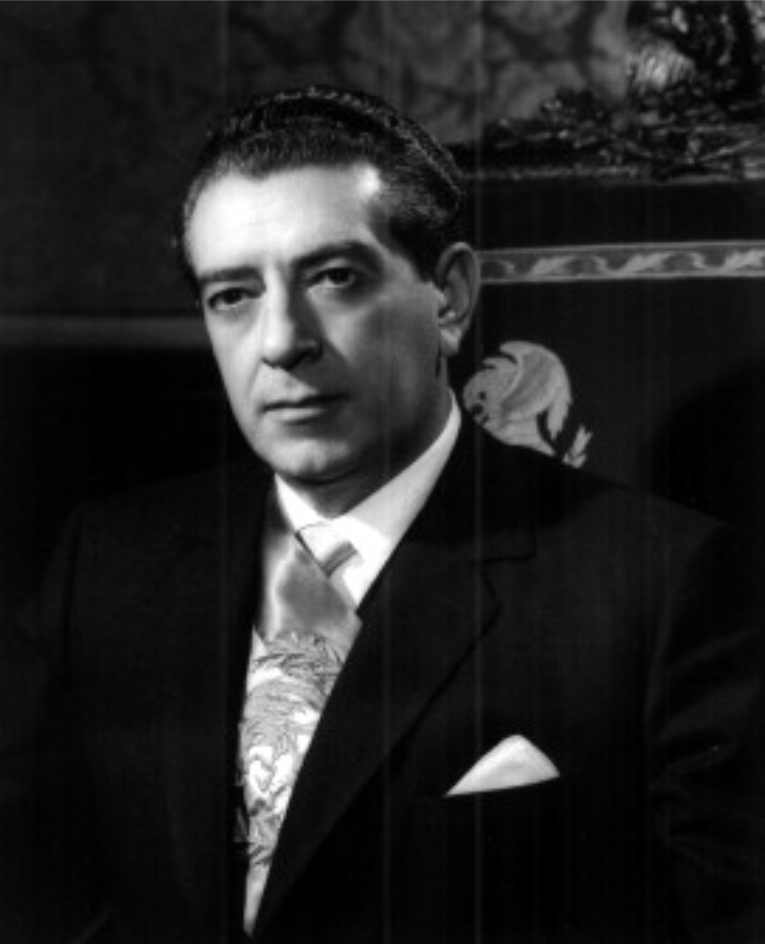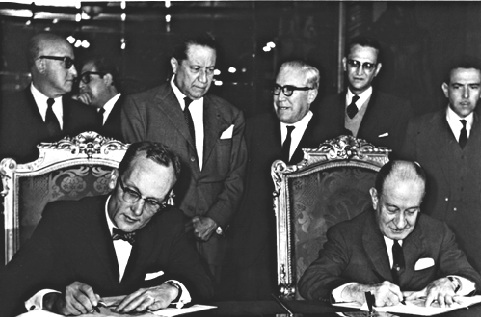|
Adolfo López Mateos
Adolfo López Mateos (; 26 May 1909 – 22 September 1969) was a Mexican politician who served as President of Mexico from 1958 to 1964. Beginning his political career as a campaign aide of José Vasconcelos during his run for president, López Mateos encountered repression from Plutarco Elías Calles, who attempted to maintain hegemony within the National Revolutionary Party (PNR). He briefly abandoned politics and worked as a professor at the Autonomous University of Mexico State, becoming a member of the PNR (renamed Party of the Mexican Revolution) in 1941. López Mateos served as senator for the State of Mexico from 1946 to 1952 and Secretary of Labor during the administration of Adolfo Ruiz Cortines from 1952 to 1957. He secured the party's presidential nomination and won in the 1958 general election. Declaring his political philosophy to be "left within the Constitution", López Mateos was the first self-declared left-wing politician to hold the presidency since Láza ... [...More Info...] [...Related Items...] OR: [Wikipedia] [Google] [Baidu] |
Adolfo Ruiz Cortines
Adolfo Tomás Ruiz Cortines (; 30 December 1889 – 3 December 1973) was a Mexican politician who served as President of Mexico from 1952 to 1958, after winning the disputed 1952 elections as the candidate of the ruling Institutional Revolutionary Party (PRI). A member of the Constitutionalist Army, Ruiz Cortines was the last Mexican president to have fought in the Mexican Revolution. He worked at the Ministry of Industry and Commerce during the administration of Adolfo de la Huerta and served as an official in the Department of Statistics from 1921 to 1935. Ruiz Cortines joined the Institutional Revolutionary Party and became Senior Official of the Government of the Federal District in 1935 and member of the Chamber of Deputies for Veracruz in 1937. In 1939 he was appointed treasurer of the presidential campaign of Manuel Ávila Camacho and worked as Governor of Veracruz from 1944 to 1948, a position he left to become Secretariat of the Interior during the administration o ... [...More Info...] [...Related Items...] OR: [Wikipedia] [Google] [Baidu] |
Lázaro Cárdenas
Lázaro Cárdenas del Río (; 21 May 1895 – 19 October 1970) was a Mexican army officer and politician who served as president of Mexico from 1934 to 1940. Born in Jiquilpan, Michoacán, to a working-class family, Cárdenas joined the Mexican Revolution and became a general in the Constitutionalist Army. Although he was not from the state of Sonora, whose revolutionary generals dominated Mexican politics in the 1920s, Cárdenas was hand-picked by Plutarco Elías Calles, Sonoran general and former president of Mexico, as a presidential candidate and won in the 1934 general election. After founding the National Revolutionary Party (PNR) in the wake of the assassination of president-elect Álvaro Obregón, Plutarco Elías Calles had unofficially remained in power during the Maximato (1928–1934) and expected to maintain that role when Cárdenas took office. Cárdenas, however, out-maneuvered him politically and forced Calles into exile. He established the structure of t ... [...More Info...] [...Related Items...] OR: [Wikipedia] [Google] [Baidu] |
Pascual Ortiz Rubio
Pascual Ortiz Rubio (; 10 March 1877 – 4 November 1963) was a first Mexican President of Mexico from 1930 to 1932. He was one of three Mexican presidents to serve out the six-year term (1928–1934) of assassinated president-elect Álvaro Obregón, while former president Plutarco Elías Calles retained power in a period known as the Maximato. Calles was so blatantly in control of the government that Ortiz Rubio resigned the presidency in protest in September 1932. Early life and education He was born in Morelia, Michoacán, the son of a lawyer and landowner, Pascual Ortiz de Ayala y Huerta, and Leonor Rubio Cornejo. He attended the Colegio de San Nicolás, in Michoacan's capital of Morelia, training as an engineer. He became politically active as a student and was opposed to the re-election of Porfirio Díaz in 1896. With the outbreak of the Mexican Revolution in 1910 and the election of Francisco I. Madero in 1911, Ortiz Rubio was elected to the federal legislature as a ... [...More Info...] [...Related Items...] OR: [Wikipedia] [Google] [Baidu] |
Guatemala
Guatemala ( ; ), officially the Republic of Guatemala ( es, República de Guatemala, links=no), is a country in Central America. It is bordered to the north and west by Mexico; to the northeast by Belize and the Caribbean; to the east by Honduras; to the southeast by El Salvador and to the south by the Pacific Ocean. With an estimated population of around million, Guatemala is the most populous country in Central America and the 11th most populous country in the Americas. It is a representative democracy with its capital and largest city being Nueva Guatemala de la Asunción, also known as Guatemala City, the most populous city in Central America. The territory of modern Guatemala hosted the core of the Maya civilization, which extended across Mesoamerica. In the 16th century, most of this area was conquered by the Spanish and claimed as part of the viceroyalty of New Spain. Guatemala attained independence in 1821 from Spain and Mexico. In 1823, it became part of the Fe ... [...More Info...] [...Related Items...] OR: [Wikipedia] [Google] [Baidu] |
Patzicía
Patzicía () is a town, with a population of 21,249 (2018 census), Population of cities & towns in Guatemala and a in the of Guatemala
Guatemala ( ; ), officially the Republic of Guatemala ( es, República de Guatemala, links=no), is a country in Central America. It is bordered to the north and west by Mexico; to the northeast by Belize and the Caribbean; ...
[...More Info...] [...Related Items...] OR: [Wikipedia] [Google] [Baidu] |
El Colegio De México
El Colegio de México, A.C. (commonly known as Colmex, English: The College of Mexico) is a Mexican institute of higher education, specializing in teaching and research in social sciences and humanities. The college was founded in 1940 by the Mexican Federal Government, the Bank of Mexico (Banco de México), the National Autonomous University of Mexico (UNAM), and the Fondo de Cultura Económica. In the late 1930s, following the end of the Spanish Civil War, Mexican president Lázaro Cardenas created the House of Spain in Mexico (1938–1940) to host Spanish intellectuals in exile in Mexico; Mexico was the only country that in 1939 welcomed Spanish refugees. Under the direction of intellectual Alfonso Reyes, the House of Spain became a higher education center, and was renamed El Colegio de México in 1940. The College now operates under a 1961 charter that allows the institution to provide college-level teaching in the fields of humanistic knowledge and social and political scien ... [...More Info...] [...Related Items...] OR: [Wikipedia] [Google] [Baidu] |
Rubén Jaramillo
Rubén Jaramillo Méndez (1900 – May 23, 1962) was a Mexican military and political leader of ''campesino'' origin who participated in the Mexican Revolution. After the Revolution, he continued to fight for the land reform promised under the Mexican Constitution. Mexican Revolution Jaramillo was born in Tlaquiltenango, Morelos, in 1900. When he was 15 years old, he joined the Liberation Army of the South under the direct command of Emiliano Zapata. By age 17, Jaramillo had been promoted to the rank of captain and commanded 75 men. During the 1920s and 1930s, Jaramillo advocated on behalf of ''ejidos'', grants of communally owned land by the federal government to farmers. He supported the 1934 presidential campaign of Lázaro Cárdenas, who created a cooperative sugar mill in Zacatepec in 1938 at Jaramillo's urging. Jaramillo was elected by the workers to help run the mill, but his advocacy on behalf of the workers led to frequent clashes with administrators appointed by the gov ... [...More Info...] [...Related Items...] OR: [Wikipedia] [Google] [Baidu] |
Valentín Campa
Valentín Campa Salazar (14 February 1904 – 25 November 1999) was a Mexican railway union leader and presidential candidate. Along with Demetrio Vallejo, he was considered one of the leaders of the 1958 railway strikes. Campa was also the founder of the National Railroad Council, and the defunct underground newspaper ''The Railwayman''. Communist Party Campa was born in Monterrey, Nuevo León, and joined the Mexican Communist Party ( es, Partido Comunista Mexicano, PCM) in 1927 at the age of 25; eventually becoming the youngest member of the parties Central Committee. Campa's views would eventually draw the ire of the party. In March 1940, he was expelled from the PCM along with the party Secretary General, Hernán Laborde. The two, along with others in the party, were removed due to their views that the assassination of Leon Trotsky should wait. Campa believed the killing of Trotsky would make him a martyr and only blacken the message of the party. In 1976, Campa was ... [...More Info...] [...Related Items...] OR: [Wikipedia] [Google] [Baidu] |
Demetrio Vallejo
Demetrio Vallejo (1912 – December 24, 1985) was a railroad worker and union activist from Tehuantepec, Oaxaca, Mexico. Vallejo began working as a railroad employee in 1928, later joining the Partido Comunista Mexicano (PCM) in 1934. Vallejo was eventually promoted to Regional Director of the PCM in Oaxaca, however later expelled in 1946. In 1946, Vallejo joined the Unified Socialist Action ( es, Accion Socialista Unificada) and later the Mexican Worker-Peasant Party ( es, Partido Obrero-Campesino Mexicano (POCM) at its founding in 1950. Vallejo was a primary leader of the Mexican railroad strikes of 1958–59. Mexican railroad union Foundation On June 26, 1958, the Union of Railroad Workers of the Mexican Republic ( es, Sindicato de Trabajadores Ferrocarrileros de la Republica Mexicana) (STFRM) Local 13 of Matias Romero, Oaxaca, began a series of escalating strikes, beginning at 2 hours in length, then expanding up to 8 hours, before finally calling a general strike. The ST ... [...More Info...] [...Related Items...] OR: [Wikipedia] [Google] [Baidu] |
Chamizal Dispute
The Chamizal dispute was a border conflict over around on the Mexico–United States border between El Paso, Texas, and Ciudad Juárez, Chihuahua. It was caused by a shift in the Rio Grande, as a survey presented in 1852 marked differences between the bed of the Rio Grande (in es, Río Bravo del Norte) and the present channel of the river.''Los Angeles Times'' (December 22, 1963) "End to the El Chamizal Affair". Tensions over the territory during the historic Taft– Diaz summit almost resulted in the attempted assassination of both presidents on October 16, 1909. The Spanish word ''chamizal'' comes from ''chamizo'', the common name for the four-wing saltbush ('' Atriplex canescens'') which covered the disputed land near the present-day park. Origins (1848–1899) The Treaty of Guadalupe Hidalgo (which officially ended the Mexican–American War) defined the international border as the line along the middle of the deepest channel in the Rio Grande, continuously in tandem with ... [...More Info...] [...Related Items...] OR: [Wikipedia] [Google] [Baidu] |



.jpg)
